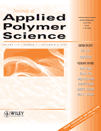Association and effective hydrodynamic thickness of hydrophobically associating polyacrylamide through porous media
Hongsheng Lu
Chengdu Institute of Organic Chemistry, Chinese Academy of Sciences, Chengdu, Sichuan 610041, People's Republic of China
College of Chemistry and Chemical Engineering, Southwest Petroleum University, Chengdu, Sichuan 610500, People's Republic of China
College of Chemistry, Graduate University of the Chinese Academy of Sciences, Beijing 100049, People's Republic of China
Search for more papers by this authorCorresponding Author
Yujun Feng
Chengdu Institute of Organic Chemistry, Chinese Academy of Sciences, Chengdu, Sichuan 610041, People's Republic of China
Chengdu Institute of Organic Chemistry, Chinese Academy of Sciences, Chengdu, Sichuan 610041, People's Republic of China===Search for more papers by this authorZhiyu Huang
College of Chemistry and Chemical Engineering, Southwest Petroleum University, Chengdu, Sichuan 610500, People's Republic of China
Search for more papers by this authorHongsheng Lu
Chengdu Institute of Organic Chemistry, Chinese Academy of Sciences, Chengdu, Sichuan 610041, People's Republic of China
College of Chemistry and Chemical Engineering, Southwest Petroleum University, Chengdu, Sichuan 610500, People's Republic of China
College of Chemistry, Graduate University of the Chinese Academy of Sciences, Beijing 100049, People's Republic of China
Search for more papers by this authorCorresponding Author
Yujun Feng
Chengdu Institute of Organic Chemistry, Chinese Academy of Sciences, Chengdu, Sichuan 610041, People's Republic of China
Chengdu Institute of Organic Chemistry, Chinese Academy of Sciences, Chengdu, Sichuan 610041, People's Republic of China===Search for more papers by this authorZhiyu Huang
College of Chemistry and Chemical Engineering, Southwest Petroleum University, Chengdu, Sichuan 610500, People's Republic of China
Search for more papers by this authorAbstract
This study was aimed at the association and effective hydrodynamic thickness of hydrophobically associating polyacrylamide (HAPAM) through porous media with coreflow experiment. It shows that there is strong hydrophobic association for HAPAM in porous media but not for polyacrylamide (PAM). The resistance factor and effective hydrodynamic thickness of HAPAM are obviously superior to those of PAM. HAPAM exhibits much stronger shear thinning behavior than PAM due to the ability to form transitional network structure. It also indicates that PAM can exhibit a transition from shear thinning behavior to shear thickening behavior at low polymer concentration. © 2008 Wiley Periodicals, Inc. J Appl Polym Sci, 2008
References
- 1
Bock, J.;Valint, P. L.,Jr.;Pace, S. J.;Siano, D. B.;Schulz, D. N.;Turner, S. R. In
Water-Soluble Polymers for Petroleum Recovery;
G. A. Stahl,
D. N. Schulz, Eds.;
Plenum Press:
New York,
1988; p
147.
10.1007/978-1-4757-1985-7_9 Google Scholar
- 2 Bock, J.;Varadaraj, R.;Schulz, D. N.;Maurer, J. J. In Macromolecular Complexes in Chemistry and Biology; P. Dubin, J. Bock, R. M. Davies, D. N. Schulz, C. Ties, Eds.; Springer: Berlin, 1994; p 33.
- 3 Glass, J. E.;Karunasena, A. Polym Mater Sci Eng 1989, 61, 145.
- 4 Glass, J. E. Associative Polymers in Aqueous Media (ACS Symposium Series); Washington, DC: American Chemical Society, 1991.
- 5
Glass, J. E.
Hydrophilic Polymers: Performance with Environmental Acceptability (Advances in Chemistry Series);
Washington, DC:
American Chemical Society,
1996.
10.1021/ba-1996-0248 Google Scholar
- 6
Glass, J. E.
Polymers in Aqueous Media: Performance Through Association (Advances in Chemistry Series);
Washington, DC:
American Chemical Society,
1989.
10.1021/ba-1989-0223 Google Scholar
- 7 Glass, J. E. Water-Soluble Polymers: Beauty with Performance (Advances in Chemistry Series); Washington, DC: American Chemical Society, 1986.
- 8 Schulz, D. N.;Bock, J. J Macromol Sci Chem A 1991, 28, 1235.
- 9
Schulz, D. N.;Bock, J.;Valint, P. L.,Jr. In
P. Dubin,
J. Bock,
R. M. Davies,
D. N. Schulz,
C. Ties, Eds.;
Macromolecular Complexes in Chemistry and Biology;
Springer:
Berlin,
1994; p
3.
10.1007/978-3-642-78469-9_1 Google Scholar
- 10
Shalaby, S. W.;McCormick, C. L.;Butler, G. B.
Water-Soluble Polymers: Synthesis, Solution Properties and Applications (ACS Symposium Series);
Washington, DC:
American Chemical Society,
1991.
10.1021/bk-1991-0467 Google Scholar
- 11
Schulz, D. N.;Glass, J. E.
Polymers as Rheology Modifiers (ACS Symposium Series);
Washington, DC:
American Chemical Society,
1991.
10.1021/bk-1991-0462 Google Scholar
- 12 Wang, T. K.;Iliopoulos, I.;Audibert, R. Polym Bull 1988, 20, 577.
- 13 Candau, F.;Selb, J. Adv Colloid Interface Sci 1999, 79, 149.
- 14 Bastiat, G.;Grassl, B.;François, J. Polym Int 2002, 51, 958.
- 15 Candau, F.;Pabon, M.;Anquetil, J. Y. Colloids Surf A 1999, 53, 47.
- 16 Schulz, D. N.;Kaladas, J. J.;Maurer, J. J.;Bock, J. Polymer 1987, 28, 2110.
- 17 Yahaya, G. O.;Ahdab, A. A.;Ali, S. A.;Abu-Sharkh, B. F.;Hamad, E. Z. Polymer 2002, 42, 3363.
- 18 Pabon, M.;Corpart, J. M.;Selb, J.;Candau, F. J Appl Polym Sci 2004, 91, 916.
- 19 Magny, B.;Lafuma, F.;Ilipoulous, I. Polymer 1992, 33, 3151.
- 20 Feng, Y.;Billon, L.;Grassl, B.;Khoukh, A.;Francois, J. Polymer 2002, 43, 2055.
- 21 Kujawa, P.;Audibert-Hayet, A.;Selb, J.;Candau, F. J Polym Sci Part A: Polym Chem 2004, 41, 3261.
- 22 Zhong, C.;Luo, P. J Polym Sci Part B: Polym Phys 2007, 45, 826.
- 23 Zhang, J.;Ye, Z. Xinjiang Petroleum Geol 2004, 25, 6.
- 24 Han, L.;Luo, P.;Ye, Z. Natural Gas Industry 2004, 24, 119.
- 25 Shi, L.;Ye, Z.;Luo, P. Natural Gas Exploration Exploitation 2004, 27, 4.
- 26 Ji, Z. PhD Thesis, Southwest Petroleum University, Chengdu, 2006.
- 27 Lu, H;Feng, Y. e-Polymers 2007, 099.
- 28 Lu, H.;Feng, Y. Presented at the National Macromolecular Conference, China, 2007.
- 29 Zaitoun, A.;Chauveteau, G. Paper Soc Pet Eng 1998, 39674.
- 30 Denys, K.;Fichen, C. ;Zaitoun, A. Paper Soc Pet Eng 2001, 64984.
- 31 Cohen, Y. Macromolecules 1988, 21, 494.
- 32 Cohen, Y.;Metzner, A. Macromolecules 1982, 15, 1425.
- 33 Gramain, Ph.;Myard, Ph. Macromolecules 1981, 14, 180.
- 34 Bagassi, M.;Chauveteau, G.;Lecourtier, J.;Englert, J.;Tirrell, M. Macromolecules 1989, 22, 262.
- 35 Chauveteau, G. J Rheol 1982, 26, 111.
- 36 Grattonia, C. A.;Luckhamb, P. F.;Jinga, X. D.;Normanc, L.;Zimmerman, R. W. J Petrol Sci Eng 2004, 45, 233.




